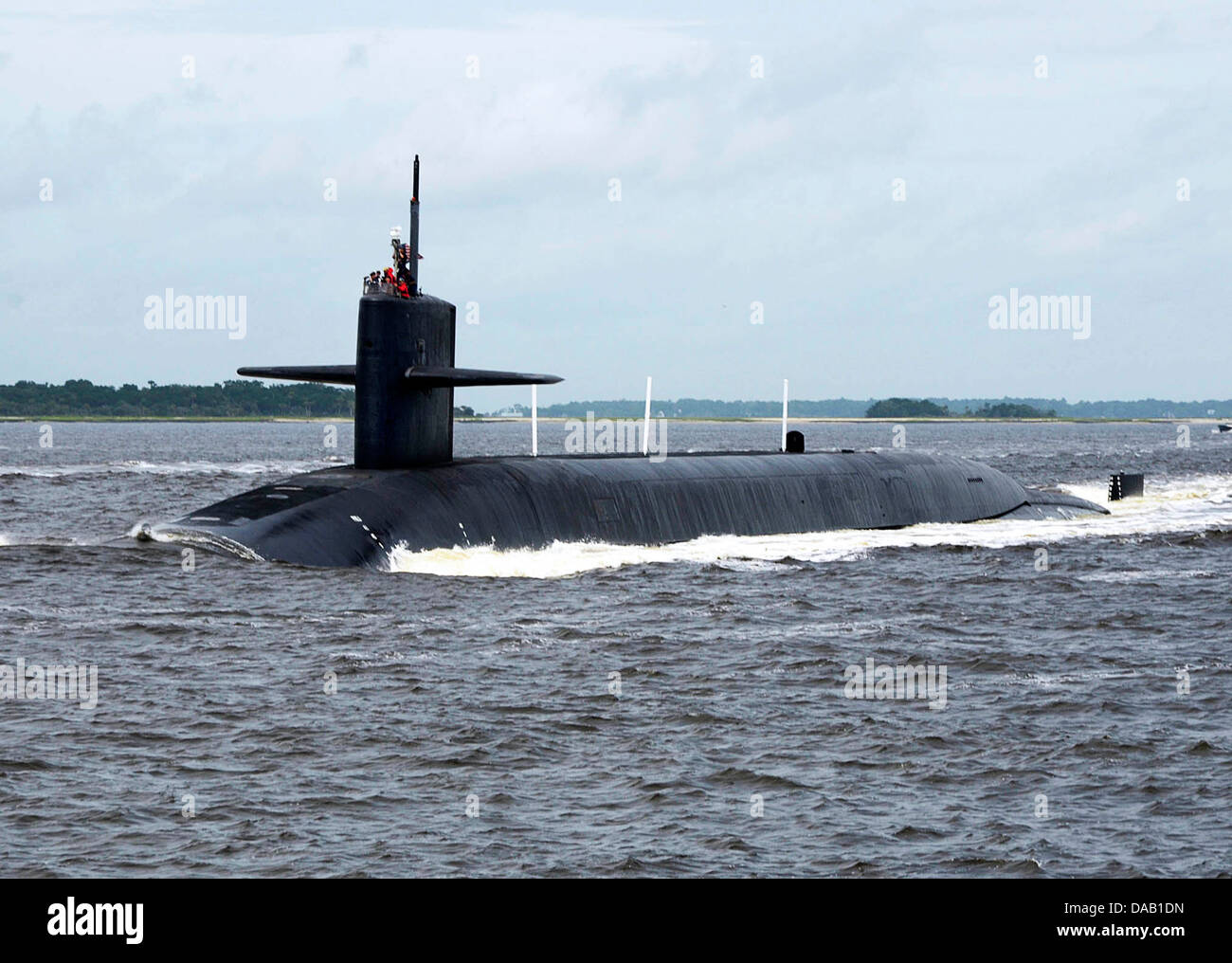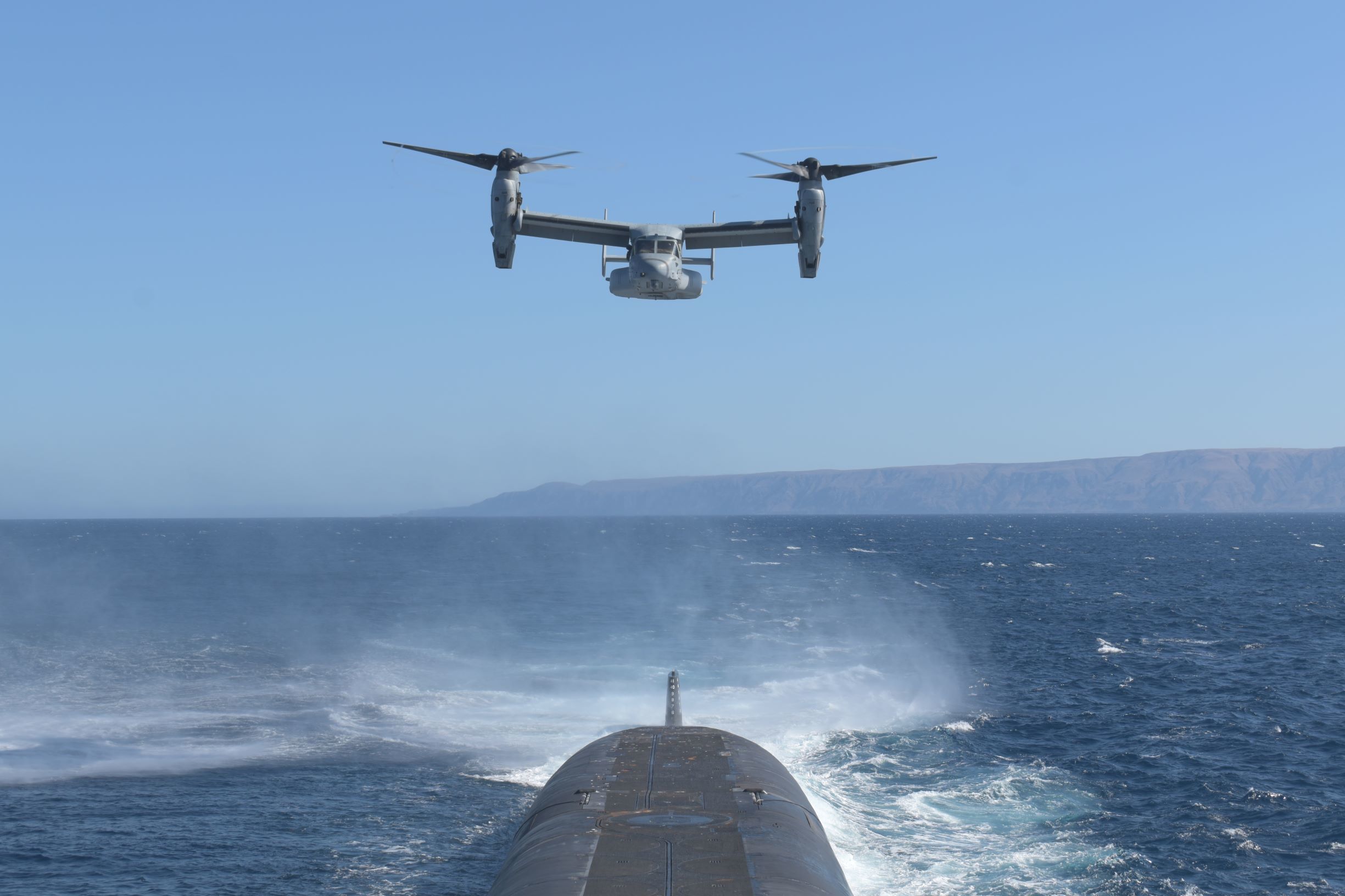Ohio Class Submarines - The Ohio class of nuclear-powered submarines includes the United States Navy's 14 ballistic missile submarines (SSBNs) and its four cruise missile submarines (SSGNs). Each of the 18,750-ton submerged ships, the Ohio-class ships are the largest submarines ever built for the United States Navy. They are the third largest submarines in the world, behind the Russian Navy's 48,000-ton Soviet-designed Typhoon-class.
With 24 Tridt II missiles each, Ohio-class ships carry more Borei-class (16, 20 for the Borei II) or Typhoon-class (20) missiles.
Ohio Class Submarines

Ohio-class SSBNs are part of the US nuclear deterrent triad, along with US Air Force strategic bombers and ICBMs.
Nuclear Armed Columbia Class Submarine Is Pentagon's Top Acquisition Priority. To Be Delivered In 2028
The 14 SSBNs together carry about half of the United States' active strategic thermonuclear warheads. Although Tridt missiles do not have pre-set targets when submarines go on patrol,
The lead submarine of this class is the USS Ohio. All Ohio-class submarines, with the exception of the USS Henry M. Jackson, are named after US states, which US Navy tradition had previously reserved for battleships and cruisers. The Ohio class will be phased out of the Columbia class beginning in 2031.
The Ohio-class submarine was designed for extended strategic deterrence patrols. Each submarine is assigned two full crews, called the blue crew and gold crew, each typically serving on deterrent patrols for 70 to 90 days. To reduce time in port for crew rotation and refueling, three large logistics hatches were installed to provide large diameter refueling and repair access. These hatches allow for rapid transfer of supply pallets, change-of-equipment modules, and machinery components, expediting submarine replenishment and maintenance. In addition, the "stealth" capability of the submarines has been significantly improved over all previous ballistic missile submarines. Ohio was virtually unnoticeable in her 1982 sea trials, providing the US Navy with highly advanced flexibility.
The class design allows the vessel to operate approximately 15 years between major overhauls. These submarines are said to be as silent at their cruising speed of 20 knots (37 km/h; 23 mph) or more as earlier Lafayette-class submarines at 6 knots (11 km/h; 6.9 mph), although they are available accurate information maintained. classified
U.s. Navy's Virginia Class Submarines To Get 76% More Firepower
Ohio-class submarines were built from hull sections, with each section having four decks 42 feet (13 m) in diameter.
The sections were manufactured at the Geral Dynamics Electric Boat facility, Quonset Point, Rhode Island, and assembled at their shipyard in Groton, Connecticut.
The United States Navy has a total of 18 Ohio-class submarines consisting of 14 ballistic missile submarines (SSBNs) and four cruise missile submarines (SSGNs). SSBN submarines provide the maritime leg of the US nuclear triad. Each SSBN is armed with up to 24 Tridt II submarine-launched ballistic missiles (SLBMs). Each SSGN is capable of carrying 154 Tomahawk cruise missiles, plus a number of Harpoon missiles to be launched through their torpedo tubes.
The Ohio class was designed in the 1970s to carry the concurrent design Tridt submarine-launched ballistic missile. The first eight Ohio-class submarines were initially armed with 24 Tridt I C4 SLBMs.
Ohio Class Submarines Archives
Starting with the ninth Tridt submarine, Tnessee, the remaining ships were equipped with the larger three-stage Tridt II D5 missile.
The Tridt I missile carries eight independently targetable repeater vehicles, while the Tridt II missile carries 12, in total providing more destructive power than the Tridt I missile and with greater accuracy. Beginning with Alaska in 2000, the Navy began converting its remaining ballistic missile submarines armed with C4 missiles to carry D5 missiles. This task was completed in mid-2008. The first eight submarines were brought to Bangor, Washington to replace the Polaris A3 missile-carrying submarines that were being decommissioned. The remaining 10 submarines were originally taken to Kings Bay, Georgia to replace the Atlantic Fleet submarines Poseidon and Tridt Backfit.
In 1994, the Nuclear Posture Review study determined that, of the 18 Ohio SSBNs that the US Navy would operate in total, 14 would be sufficient for US strategic needs. The decision was made to convert four Ohio-class ships into capable SSGNs. carry out conventional land attacks and special operations. As a result, the four oldest ships in the class - Ohio, Michigan, Florida and Georgia - phased out the conversion process in late 2002 and returned to active service in 2008.
From then on, the ships could carry 154 Tomahawk cruise missiles and 66 special operations personnel, among other capabilities and upgrades.
Dod Ig Report On Ohio Class Submarine Sustainment
During the conversion of the first four submarines to SSGNs (see below), five of the submarines, Pnsylvania, Ktucky, Nebraska, Maine and Louisiana, were transferred from Kings Bay to Bangor. Further transfers occur as US strategic weapons objectives change.
In 2011, Ohio-class submarines conducted 28 deterrence patrols. Each patrol lasts approximately 70 days. Four vessels are on station ("hard alert") in designated patrol areas at any given time.
The conversion modified 22 of the 24 88-inch (2.2 m) diameter Tridt missile tubes to hold large vertical launch systems, one configuration of which can be a group of seven Tomahawk cruise missiles. In this configuration, the number of cruise missiles carried could be a maximum of 154, the equivalent of what is normally deployed in a surface battle group. Other payload possibilities include new generations of supersonic and hypersonic cruise missiles and submarine-launched intermediate-range ballistic missiles,

Unmanned aerial vehicles, the ADM-160 MALD, ssor for anti-submarine warfare or intelligence, surveillance and reconnaissance missions, mine warfare payloads such as the AN/BLQ-11 long-range mine reconnaissance system and the affordable stealthy universal float launcher. capsule system specialized payload capsules.
Buy Ohio Class Submarines On Deck Book Online At Low Prices In India
Missile tubes also have room for stowage pods that can extend forward deployment time for Special Forces. The other two Tridt tubes become the swimmer's closed chambers. For special operations, the SEAL Advanced Delivery System and dry deck shelter can be mounted in the lock chamber, and the ship will be able to accommodate up to 66 special operations or Navy sailors, such as Navy SEALs or USMC MARSOC teams. Improved communications equipment installed during the upgrade allows SSGNs to serve as joint command Cters for small forward-deployed and stowaway combatants.
On 26 September 2002, the Navy awarded Geral Dynamics Electric Boat a $442.9 million contract to begin the first phase of the SSGN submarine conversion program. These funds only covered the initial conversion phase of the first two ships of the programme. The Advance Purchase was funded at $355 million in FY 2002, $825 million in the FY 2003 budget, and through the five-year defense budget plan, $936 million in FY 2004, $505 million in in fiscal 2005 and $170 million in fiscal 2006. Therefore, the total cost to upgrade all four vessels is just under $700 million per vessel.
In November 2002, Ohio broke into dry dock, commencing her 36-month missile refueling and conversion overhaul. Electric Boat announced on January 9, 2006 that the conversion was complete. Converted Ohio joined the fleet in February 2006, followed by Florida in April 2006. Converted Michigan was delivered in November 2006. Converted Ohio weighed at sea for the first time in October 2007. Re. Bay
These four SSGNs are expected to remain in service until approximately 2023-2026. At this time, her capabilities will be replaced by a Virginia-class submarine equipped with the Virginia payload module.
Ohio Class Submarine Model
As part of the New START treaty, four tubes on each SSBN were deactivated in 2017, reducing the number of missiles to 20 per ship.
Line drawing of the Ohio class in its original SSBN configuration. (1) Sonar Dome, (2) Main Ballast Tanks, (3) Computer Room, (4) Integrated Radio Room, (5) Sonar Room, (6) Command and Control Room, (7) Sailing Boat, (8) Missile Control Boat, (9) Engine Room, (10) Reactor Bay, (11) Auxiliary Engine Room No. 2, (12) crew berth, (13) auxiliary engine room no. 1, (14) Torpedo Room, (15) Dressing Room, (16) Chief Petty Officer's Quarters, (17) Missile Compartment
Note: Vessels based at Naval Submarine Base Kitsap, Washington are operated by the United States Pacific Fleet, while vessels based at Naval Submarine Base Kings Bay, Georgia are operated by United States Fleet Forces Command (formerly US Atlantic Fleet).

Thus the replacement submarine must be seaworthy at the time. A replacement can cost more than $4 billion per unit compared to Ohio's $2 billion.
File:ohio Class Submarine Launches Tomahawk Cruise Missiles (artist Concept).jpg
The US Navy is exploring two options. The first option is a variant of the Virginia-class nuclear-powered attack submarines. The second option is a dedicated SSBN, either with a new hull or based on a revision of the Ohio currt class.
With the collaboration of Electric Boat and Newport News Shipbuilding, in 2007, the US Navy began a cost control study.
In December 2008, the US Navy awarded Electric Boat a contract to design the Ohio-class replacement missile compartment, worth up to $592 million. Newport News is expected to receive about 4% of this project. In April 2009, US Secretary of Defense Robert M. Gates said the US Navy should have started this program in 2010.
The new vessel was expected to complete the design phase in 2014. If a new hull design were to be used, the program would have to start in 2016 to meet the 2029 deadline.
Virginia Class Submarines: Getting More Capability To The Fleet Faster
The Columbia class was officially designated on December 14, 2016 by Secretary of the Navy Ray Mabus and the lead submarine will be the USS Columbia (SSBN-826).
In 2020, Navy officers

0 Comments